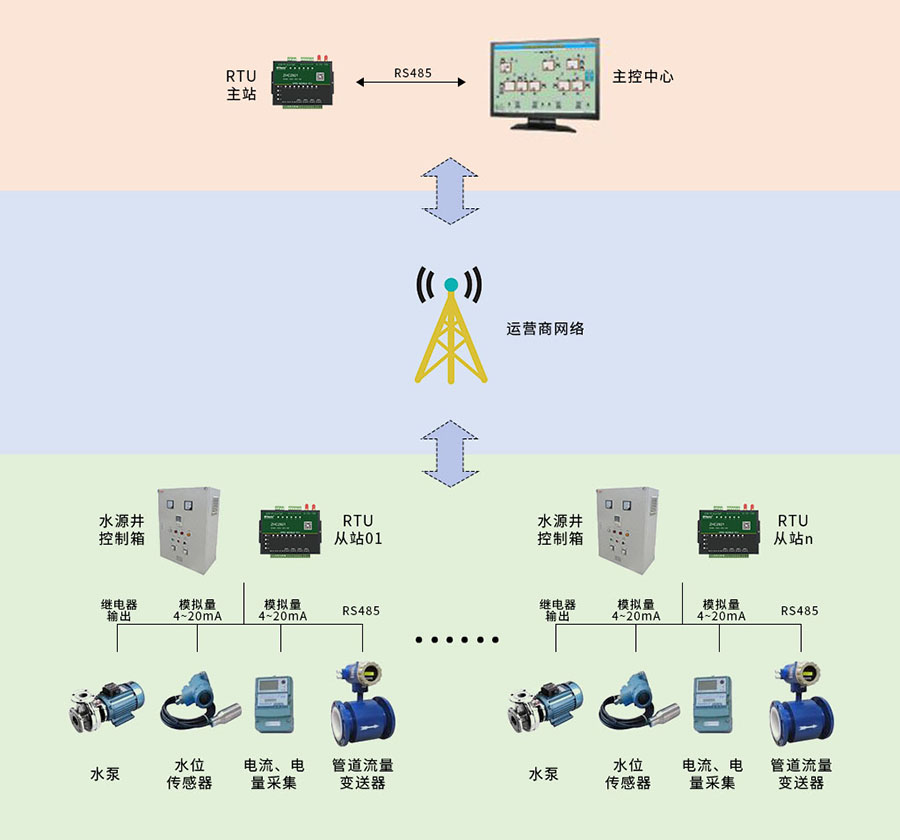In recent years, our city’s surface water supply has become increasingly tight and has been polluted to varying degrees, which has seriously affected the city’s economic development and citizens’ lives. With the rapid development of urban construction, the requirements for water supply quality are also constantly increasing. It is imperative to realize comprehensive automation of operation, control and management of water supply systems.
Since the geographical location of the well group is very dispersed and the dungeons are widely distributed, wireless communication is suitable.
This solution mainly solves the problem of collecting and monitoring the data of each well in the central control room of the water plant. The entire system includes a master station and multiple slave stations. Among them, the master station is located in the central control room of the water plant, and the slave stations are located at each water source well. This system is a typical point-to-multipoint star structure wireless communication system.


A wireless remote control network composed of RTU and PLC is used to remotely monitor hundreds of equipment within an area of more than 1,000 square kilometers, realizing unattended remote pumping stations.
The hardware of the wireless network includes RTU, PLC, relay tower, and main communication tower. A good topology is easy to maintain and fault location is relatively easy. In the control system, the RTU is responsible for sending and receiving data and is a key device of the wireless control network. Stable communication in wireless networks depends on the distance between each site and the communication tower and the site polling mechanism.
The RTU is sturdy and durable, has high receiving sensitivity, strong anti-interference ability, and fast data transmission conversion time. It also provides a standard RS485 interface, which can be directly connected to data terminals such as computers and PLCs to achieve transparent transmission.
Control system functions and requirements
Because the wells are scattered and scattered, no one is responsible for them. In order to reduce labor intensity, operators can perform remote wireless operation control according to water supply needs in the factory dispatching room. At the same time, they can monitor the operating parameters of each deep water well, thereby achieving centralized monitoring.
1. Reliability and safety
Since each well serves as the raw water for the water plant, the safety and stability of its control system directly affects whether the water plant can provide normal water supply to the urban area. Therefore, we must improve the reliability of communication equipment, primary instruments and control equipment, and program programming in the system.
2. Maintainability
System software, application software and hardware must have powerful alarm and fault self-diagnosis functions so that engineering and technical personnel can analyze and maintain system faults.
3. Scalability
The system should use hardware equipment that has certain standards and is widely used, mainly to consider the development and expansion of the system and lay a solid foundation for future system connections.
4. Report and query functions
There is complete historical data storage for well group operating parameters. It is generally required to store data every 15 minutes for query and related statistical analysis. It can print daily production reports and monthly production reports at the same time.
5. With fault diagnosis and alarm processing functions
Monitor special operating status in the system, such as: power-on status, communication status, water pump operating status, local/remote status, etc. When these special status bits change, an alarm should be made in time. At the same time, the relevant information when these status bits change should be recorded, such as: fault tag name, alarm information, fault alarm time and alarm confirmation time, etc., and the alarm information should be managed. .
